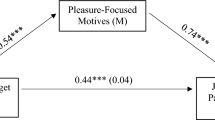Abstract
Examining the content of personal ads is one way to determine what individuals desire in partners and what they believe others desire. In the current study we examined heterosexual women, lesbians, and bisexual women seeking female partners. We predicted that gender as well as sexual orientation would impact the number of physical attributes requested and offered. Personal ads were collected from alternative newspapers and one internet site. A total of 357 ads by lesbians, 135 by bisexual women seeking women, and 334 ads by heterosexual women were examined for physical descriptors, including weight. Bisexual women offered the most physical descriptors and lesbians the least. Bisexual women also requested more physical attributes and offered more weight descriptors than did lesbians and heterosexual women. Results suggest that what women want and offer differ by partner choice and sexual orientation.
Similar content being viewed by others
REFERENCES
Bailey, J. M., Kim, P. Y., Hills, A., & Linsenmeier, J. A. W. (1997). Butch, femme, or straight acting? Partner preferences of gay men and lesbians. Journal of Personality and Social Psychology, 73, 960-973.
Beren, S. E., Hayden, H. A., Wilfley, D. E., & Striegel-Moore, R. H. (1997). Body dissatisfaction among lesbian college students: The conflict of straddling mainstream and lesbian cultures. Psychology of Women Quarterly, 21, 431-445.
Blumstein, P., & Schwartz, P. (1983). American couples. New York: Morrow.
Brand, P. A., Rothblum, E. D., & Solomon, L. J. (1992). A comparison of lesbians, gay men, and heterosexuals on weight and restrained eating. International Journal of Eating Disorders, 11, 253-259.
Buss, D. M., & Schmitt, D. P. (1993). Sexual strategies theory: An evolutionary perspective on human mating. Psychological Review, 100, 204-232.
Child, M., Low, K. G., McCormick, C. M., & Cocciarella, A. (1996). Personal advertisements of male-to-female transsexuals, homosexual men, and heterosexuals. Sex Roles, 34, 447-455.
Deaux, K., & Hanna, R. (1984). Courtship in the personals column: The influence of gender and sexual orientation. Sex Roles, 11, 363-375.
Doojse, B., Rojahn, K., & Fischer, A. (1999). Partner preferences as a function of gender, age, political orientation and level of education. Sex Roles, 40, 45-60.
Epel, E. S., Spanakos, A., Brownell, K. D., & Kasl-Godley, J. (1996). Body shape ideals across gender, sexual orientation, socieconomic status, race, and age in personal advertisements. International Journal of Eating Disorders, 19, 265-273.
Feingold, A. (1992). Sex differences in the effects of similarity and attractiveness on opposite-sex attraction. Basic and Applied Social Psychology, 12, 357-367.
Furnham, A. F., & Radley, S. (1989). Sex differences in the perception of male and female body shapes. Personality and Individual differences, 10, 653-662.
Gettleman, T. E., & Thompson, J. K. (1993). Actual differences versus stereotypical perceptions of body image and eating disturbance: A comparison of male and female heterosexual and homosexual samples. Sex Roles, 29, 545-562.
Goodwin, R. (1991). Sex differences among partner preferences: Are the sexes very similar? Sex Roles, 23, 501-513.
Harris, M. B., Walters, L. C., & Waschull, S. (1991). Gender and ethnic differences in obesity-related behaviors and attitudes in a college sample. Journal of Applied Social Psychology, 21, 1545-1577.
Harrison, A. A., & Saeed, L. (1977). Let's make a deal: An analysis of revelations and stipulations in lonely hearts advertisements. Journal of Personality and Social Psychology, 35, 257-264.
Hatala, M. N., & Prehodka, J. (1996). Content analysis of gay male and lesbian personal advertisements. Psychological Reports, 78, 371-374.
Heffernan, K. (1999). Lesbians and the internalization of societal standards of weight and appearance. Journal of Lesbian Studies, 3, 121-127.
Herzog, D. H., Newman, K. L., Yeh, C. J., & Warshaw, M. (1992). Body image satisfaction in homosexual and heterosexual women. International Journal of Eating Disorders, 11, 391-396.
Hutchinson, L., & Kaahumanu, L. (1991). Bi any other name. Boston: Alyson Publications.
Koestner, R., & Wheeler, L. (1988). Self-presentation in personal advertisements: The influence of implicit notions of attraction and role expectation. Journal of Social and Personal Relationships, 5, 149-160.
Laner, M. R. (1978). Media mating. II: “Personals” advertisements of lesbian women. Journal of Homosexuality, 4, 41-61.
Lynn, M., & Shurgot, B. A. (1984). Responses to lonely hearts advertisements: Effects of reported physical attractiveness, physique, and coloration. Personality and Social Psychology Bulletin, 10, 349-357.
Murstein, B. I., Merighi, J. R., & Malloy, T. E. (1989). Physical attractiveness and Exchange Theory in interracial dating. Journal of Social Psychology, 129, 325-334.
Myers, A., Taub, J., Morris, J. F., & Rothblum, E. D. (1999). Beauty mandates and the appearance obsession: Are lesbian and bisexual women better off? In J. C. Cogan & J. M. Erickson (Eds.), Lesbians, levis, and lipstick: The meaning of beauty in our lives (pp. 15-26). New York: Haworth Press.
Nell, K., & Ashton, N. L. (1997). Gender, self-esteem, and perception of own attractiveness. Perceptual and Motor Skills, 83, 1105-1106.
Rust, P. C. (1993). Neutralizing the political threat of the marginal woman: Lesbians' beliefs about bisexual women. Journal of Sex Research, 30, 214-228.
Siever, M. D. (1994). Sexual orientation and gender as factors in socioculturally acquired vulnerability to body dissatisfaction and eating disorders. Journal of Consulting and Clinical Psychology, 62, 252-260.
Taub, J. (1998, March). Bisexual women and beauty norms: Aqualitative examination of the effects of feminism and women's communities. Paper presented at the annual meeting of the Association for Women in Psychology, Baltimore, MD.
Taub, J. (1999). Bisexual women and beauty norms: A qualitative examination of the effects of coming out and gender of partner. In J. C. Cogan & J. M. Erickson (Eds.), Lesbians, levis and lipstick: The meaning of beauty in our lives (pp. 27-36). New York: Haworth Press.
Taylor, S. E., Peplau, L. A., & Sears, D. O. (2000). Social psychology (10th ed.). Upper Saddle River, NJ: Prentice-Hall.
Author information
Authors and Affiliations
Rights and permissions
About this article
Cite this article
Smith, C.A., Stillman, S. What Do Women Want? The Effects of Gender and Sexual Orientation on the Desirability of Physical Attributes in the Personal Ads of Women. Sex Roles 46, 337–342 (2002). https://doi.org/10.1023/A:1020280630635
Issue Date:
DOI: https://doi.org/10.1023/A:1020280630635




